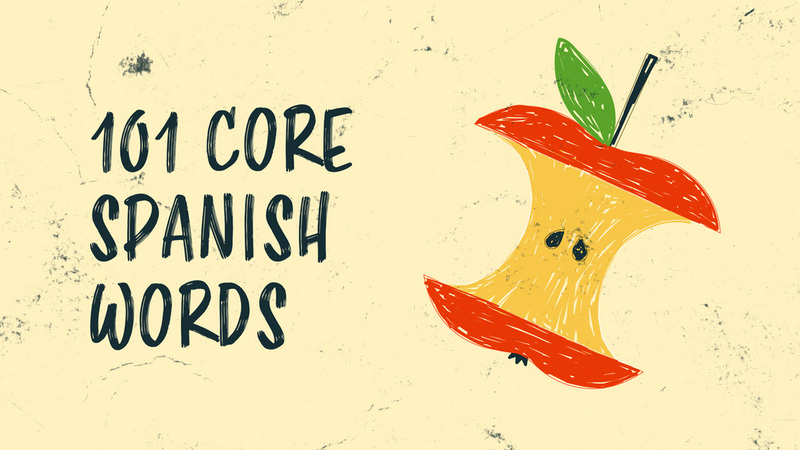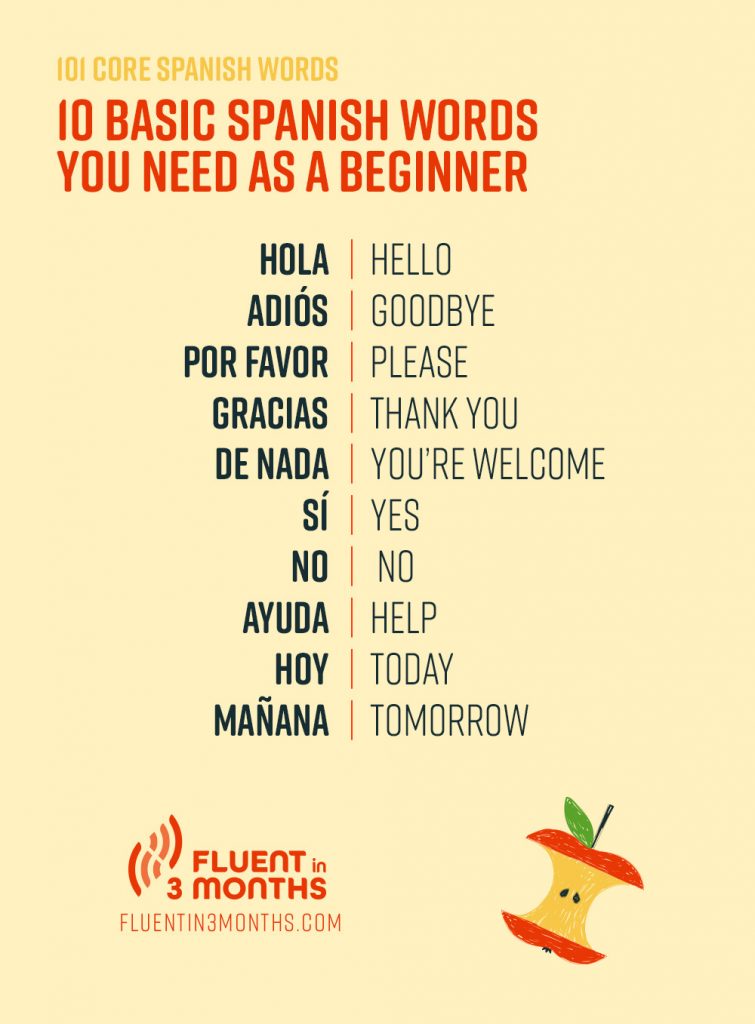The 111 Most Common Spanish Words For Everyday Use
What if I told you that you could understand about 50% of Spanish by learning only 100 Spanish words?
Would you think I’m crazy, or would you give it a shot?
It’s true! By learning the 111 most common Spanish words, you can begin to understand half of the language.
I know that sounds far fetched, but hear me out. We use a lot of the same words… all the time.
In English, words like “the”, “a”, “and”, “I”, “you”, “is”, and more are used in almost every sentence. The same is true in Spanish. This is good news, since many people struggle to learn thousands of words. But you don’t need to!
That’s why one of the best ways to go from 0-50% as a beginner Spanish speaker is to start off learning these 111 core Spanish words. It’ll not only help you make the most out of your study time, but it’ll give you a major leg up right away.
After all, it doesn’t take much to memorize your first 111 words when you use the right techniques!
Table of contents
- 10 Basic Spanish Words You Need As a Beginner
- 36 Core Spanish Nouns
- Spanish Nouns for Things
- Spanish Nouns for People
- 25 Core Spanish Verbs
- 31 Basic Spanish Adjectives and Adverbs
- 9 Common Spanish Words for Conjunctions and Connectors
- Why Learn Spanish Words by Word Frequency?
- Build Your Spanish Word Bank with The Most Common Words in Spanish
get into the article, if you are interested in learning Spanish yourself, you should check out my absolute favourite resource for learning Spanish, SpanishPod101.
Every time I refresh my Spanish, this has been by far my favourite resource, since it’s a podcast style learning resource that covers many aspects of the language much better than traditional courses do.
It also tackles the issue of listening comprehension better than literally anything else out there, since its catalogue of lessons eases you in with simple lessons at first that get progressively harder, and you can listen to them for a huge range of topics better suited to your hobbies and interests.
They have a free option for anyone who wants to test them out, based on just their limited recent episodes, but exclusively for Fi3M readers, you can get 20% off if you sign-up for any of their subscriptions, which allow you to access their full catalog of many hundreds of lessons, using the code FLUENT3.
I highly recommend this to all Spanish learners!!
10 Basic Spanish Words You Need As a Beginner
If you’re only going to learn 10 words from this post, these are the ones you need:
- Hola – “hello”
- Adiós – “goodbye”
- Por favor – “please”
- Gracias – “thank you”
- De nada – “you’re welcome”
- Sí – “yes”
- No – “no”
- Ayuda – “help”
- Hoy – “today”
- Mañana – “tomorrow”
To prepare for learning the other words in this article, you can use the resources from this video:
36 Core Spanish Nouns
These will be your most helpful nouns starting out. Of course, you may have different nouns you use in everyday life… And you can change this list according to that! But since we’re going by word frequency here, these words will be useful to know.
Spanish Nouns for Time
- Vez – “One time”
- Hoy – “Today”
- Mañana – “Tomorrow”
- Ayer – “Yesterday”
- Hora – “Hour”
- Año – “Year”
- Día – “Day”
- Semana – “Week”
- Antes – “Before”
- Después – “After”
- Tiempo – “Time” or “Weather”
Spanish Nouns for Places
- Aquí – “Here”
- Allí – “There”
- Ahora – “Now”
- Sitio – “Place”
- Escuela – “School”
- Tienda – “Shop”
- Baño – “Bathroom”
- Ciudad – “City”
- País – “Country”
Spanish Nouns for Things
- Cosa – “Thing”
- Nada – “Nothing”
- Algo – “Something”
- Este/Esto/Esta – “This” or “This one”
- Ese/ Eso/Esa – “That” or “That one”
- Casa – “House”
- Coche – “Car”
- Idioma – “Language”
- Agua – “Water”
- Película – “Movie”
Spanish Nouns for People
- Hombre – “Man”
- Mujer – “Woman”
- Chico/Chica – “Boy”/”Girl”
- Amigo – “Friend”
- Persona – “Person”
- Familia – “Family”
25 Core Spanish Verbs
These are the most common Spanish verbs, and you can say quite a lot with only these 25 Spanish words! The first six verbs listed, especially. These verbs are often used with other verbs to create more complex sentences.
A couple of notes here. The first two verbs, ser and estar both mean “to be.” But ser is used for permanent situations. For example, “soy Caitlin” means “I am Caitlin.” (Soy is ser conjugated for the first person.)
We use soy because my name is Caitlin, and unless I decide to change it, it will always be Caitlin.
Estar is used for situations that could change. For example, “estoy bien” means “I’m fine.” (Estoy is estar conjugated for the first person as well.) We use estar for this because I’m fine right now… But tomorrow, who knows? Maybe it’ll be a rough day, and I actually “no estoy bien.” (Or “not well.”)
The other note I have for you is that these verbs are unconjugated, so they’re in their infinitive, or dictionary, form. Many are irregular Spanish verbs because they’re so common. The more common words are, the more they change over time causing them to become irregular. But, these verbs are so common, it’ll be easy to master once you get to it!
- Ser – “To be” (permanent)
- Estar – “To be” (non-permanent)
- Haber – “To have”, “To exist”
- Tener – “To have”, “To own”
- Hacer – “To do”, “To make”
- Poder – “Can do”
- Ver – “To see”
- Ir – “To go”
- Dar – “To give”
- Saber – “To know”
- Querer – “To want”, “To love”
- Creer – “To believe”
- Hablar – “To talk”
- Llevar – “To carry”
- Encontrar – “To find”
- Gustar – “To like”
- Decir – “To tell”
- Venir – “To come”
- Pensar – “To think”
- Entender – “To understand”
- Leer – “To read”
- Comer – “To eat”
- Beber – “To drink”
- Trabajar – “To work”
- Usar – “To use”
31 Basic Spanish Adjectives and Adverbs
These adjectives will come in handy all the time in Spanish! It’s a good idea to memorize them in sets whenever possible. Like mucho for “a lot” and poco for “a few.” This way you can associate the two words together, making them easier to remember.
And words like bueno can also be used as connecting words. Because bueno is so common, in some dialects like Mexican Spanish, it’s used to say “well then”, “okay”, or “anyway…”
- Todo – “All”, “every”
- Alguno – “Some”
- Más – “More”
- Menos – “Less”
- Muy – “Very”
- Mucho – “A lot”
- Otro – “Other”
- Casi – “Almost”
- Mismo – “Same”
- Así – “Like this”
- También – “Also”
- Hasta – “Until, Even”
- Grande – “Large”
- Pequeño – “Small”
- Bien – “Well”
- Poco – “A little bit”
- Siempre – “Always”
- Nunca – “Never”
- Cada – “Each”
- Nuevo – “New”
- Antigua – “Old”
- Bueno – “Good”
- Mal – “Bad”
- Alto – “High”
- Bajo – “Low”
- Lejos – “Far”
- Cerca – “Near”
- Hermosa – “Beautiful”
- Feo – “Ugly”
- Difícil – “Difficult”
- Fácil – “Easy”
9 Common Spanish Words for Conjunctions and Connectors
Conjunctions and connectors help your speech flow in a natural way. They help you make more complex sentences, as well as pause for thought without adding awkward silence to your conversations. Conversation connectors are a valuable tool for your first conversations in Spanish. So here are the nine most common to help you get started:
- Que – “That”, “Which”
- Como – “Like”, “As”
- Pero – “But”
- Porque – “Because”
- Entonces – “So”, “Then”
- Pues – “Well then”
- Aunque – “Although”
- Mientras – “While”
- Además – “Besides that”
Why Learn Spanish Words by Word Frequency?
These 100 Spanish words are chosen based on analyses of books, websites, newspapers, and more, by word frequency.
The word frequency method helps you learn the most common words first, so you can start understanding more of Spanish speech immediately.
This is a lot more effective than textbooks that start by teaching you Spanish words for the classroom, random careers or college majors. Most of those words you’ll never use again after that. (Seriously, I learned how to say “economics” – ciencias económicas – but I’ve never once talked about that in Spanish.)
The words on this list you’ll use, hear, or read all the time. That not only helps you understand faster, it helps you remember them faster, too, because you see them often. That’s why this is my favorite method for learning new words when I first start learning a language.
And it’s interesting because learning your first 100 words can get you up to 50% fluent, and 1,000 words can help you understand about 88% of what’s spoken in Spanish.
Contrast that with 3,000 words, which would get you to about 94% fluency (only a 6% increase!). So those 100 common Spanish words give you a lot of mileage in the language.
That’s not to say you shouldn’t learn more words – you definitely should. But it just shows you the power of learning the most common words first. It’s one way to study more effectively and get the most out of your time right away.
Now, one thing about this article. I’ll be skipping common Spanish articles like “el,” “la,” “un,” “y,” “o,” “con,” and other words like them. Why? Because these words mean “the,” “an,” “and,” etc… They’re repetitive and quick to learn in a grammar lesson, rather than vocabulary. So, we’ll be skipping over those here and focusing on other important words to know.
I’m also not including personal pronouns or the various conjugations of common verbs. Again, that goes back to learning grammar and conjugation. It’s important to know, but most “word frequency lists” take up a lot of space with various conjugations of the same word. Instead, learn the dictionary form now and how to conjugate it later! You can learn your Spanish pronouns in this article, and basic verb conjugation here.
Once you know these 101 core Spanish words, it becomes much easier to build simple Spanish sentences and start speaking now!
Build Your Spanish Word Bank with The Most Common Words in Spanish
Now that you’ve looked over the 101 most common Spanish words, it’s time to memorize them. Add these words to your Anki flashcard deck, or another app you use for memorizing vocab. After that, your next steps would be to learn how to conjugate Spanish verbs, build your Spanish conversation script, and study essential Spanish sentences and phrases.
Then it’s time to find a Spanish language exchange partner and start speaking! Because if you don’t use it, you lose it.
And don’t forget to start building on this list with words you use every day. That will be unique to you, and help you really start learning Spanish you’ll actually use. Learn words to talk about your career, your hobbies, your daily routine, or where you live. Build on that, so you can have a more expressive conversation!




Social